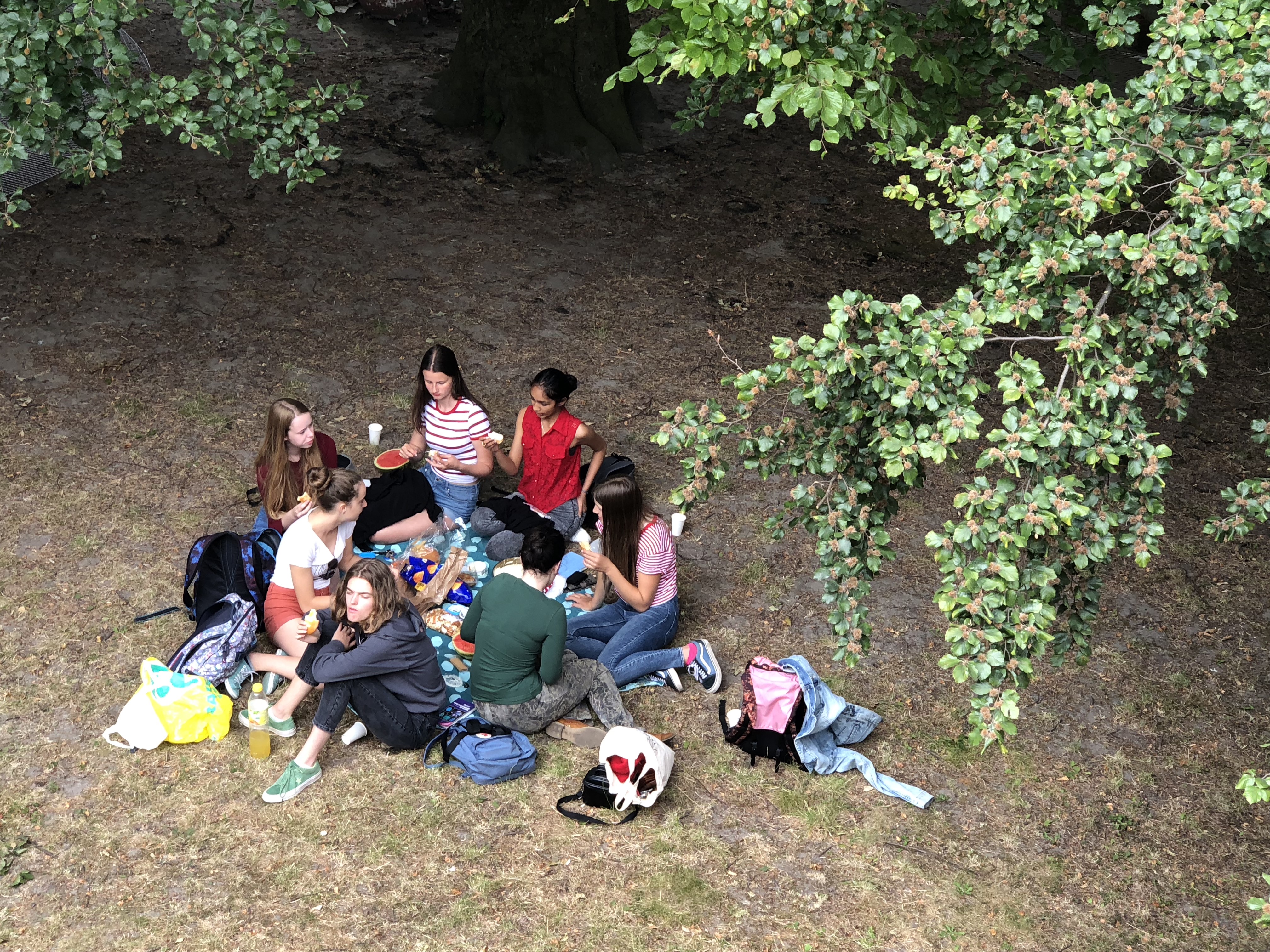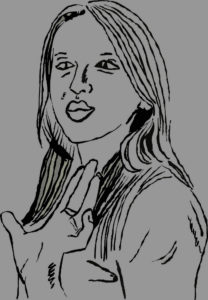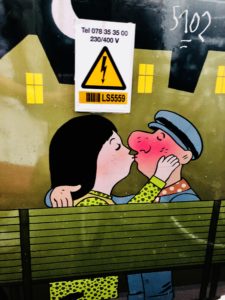2018.7.9 — 2018.7.15
2018.7.9
Day 9: National Maritime Museum, Icebar
After a two-hour lecture on the colonial history of the Netherlands (with a special focus on the Dutch East India Company and the West India Comany), we went to the Het Scheepvaartmuseum, or National Maritime Museum.

The Dutch Republic’s economic success is mainly based on four factors. First, its location neighboring the North sea expedited the flourishing of fishery, shipping, shipbuilding and navigation. Second, the foreign trade led to a particularistic government, in which the merchants became the elites and businessmen dominated politics. Third, immigrants, such as Portugal Jews, set up business in Amsterdam, Haarlem, Leiden and Middelburg in the Netherlands and helped boost the economy. Last but not least, the infrastructure provided great convenience to the trade business. For example, there were many lanes built for horses for the 17th century means of transportation: the “trekschuit” — an old style sail- and horse-drawn boat. On a side note, these trekvliet nowadays has become bike lanes for numerous local bikers.
The great Dutch expeditions and overseas trade were made possible by the development of cartography, the discovery of ways to measure altitude/longitude/speed/direction/depth and the invention of pendulum clock by Christiaan Huggens. In the National Maritime Museum, there is a fantastic exhibition room with walls decorated as dark starry sky, which tells you all about new instruments and methods invented at the 17th century for sailors to find their way to destinations.

There is now also a temporary exhibition on Joan Blaeu’s map of the world from 1648. Over 2 by 3 meters, the size is impressive and at that time displayed the most up-to-date knowledge of the world. Using a magnifying glass, you will see and become amazed by all the tiny details drawn by hand on the huge map.

The VOC (Dutch East India Company) and WIC (Dutch West India Company) were founded in 1602 and 1621 respectively. They were the largest and most extensive maritime trading companies at the time, and used to hold a monopoly on important European shipping routes eastward around Africa, past the Cape of Good Hope, and westward through the Southern Hemisphere around South America through the Strait of Magellan. Dutch navigators at that time explored new trade passages between Asia and Europe and charted vast regions such as New Zealand, Tasmania, and pasts of the east coast of North America.
My favorite part of the museum is the East Indiaman Amsterdam experience. The giant ship moored along the building is an exact replica of the famous Dutch East Indiaman (ships that sail to the Far East) sank and lost during a storm on its first voyage in 1749.


Inside the ship, there is a VR exhibition called Dare to Discover, which will take you all the way back to the Dutch Golden Age in the 17th century, when Amsterdam was the world’s largest port and Netherlands was undoubtedly a world power. Putting on the VR goggle, you will see from a bird’s eye view the grand construction of the Zeemagazijn —now home to Het Scheepvaartmuseum — as well as the blooming shipbuilding industries on the shipyard premises. Nearby is the exhibition of the Royal Barge built for Willem I.

Shortly after reaching its peak, the Dutch Empire began to decline after the several Anglo-Dutch Wars, in which it lost many of its colonial possessions and trade monopolies to the British Empire. In the museum, you can see some scenes of the marine battles from the 17th century Dutch sea paintings, which serve as a reminder of the prosperous times of the Dutch Golden Age.


Later on, in 1942, Japan invaded the Netherlands East Indies, and the Dutch surrendered two months later in Java. The Japanese backed Indonesian nationalism under the leadership of Sukarno. New indigenous institutions were also created. Two days after the Japanese surrender at WWII in August 1945, Indonesian independence was declared. But the Dutch tried to re-establish their colony and eventually re-occupied most of the colonial territory, kindling a guerrilla struggle. It was not under international pressure, the Netherlands formally recognized Indonesian sovereignty in 1949 and transferred all territories back to Indonesia in 1962.
On the west side, in 1954, the Netherlands, Suriname and the Netherlands Antilles became a composite kingdom. The former colonies were granted autonomy, except for certain matters such as foreign affairs and citizenship, which were the duties of the Realm. After several unrest and negotiations, full independence was grated to Suriname in 1975, with around 60,000 emigrants choosing to move to the Netherlands. Aruba seceded from the Netherlands Antilles federation in 1986 and remained a Realm in its own right of its own choice. In 2010, the Netherlands Antilles were dissolved. Curaçao and other former territories acceded to the same country status within the Kingdom that Aruba has already become.
It is through this eye-opening colonial history, that we can understand the present-day multicultural society in the Netherlands and the Dutch legacy present all over the world.
We left the museum when it closed at 5. My friends and I walked for about half an hour from the east part of Amsterdam to a restaurant at city center. Along the streets, there are many quaint little shops selling antique toys, tobacco pipes, colorful E-cigs, old books, debauched artworks, Dutch-fashion clothes and gaudy-looking desserts.





The night was getting more and more chilly. In accordance with the sudden drop of temperature, we went to the famous Amsterdam Icebar right after dinner. The bar is kept at a constant temperature of -10 degree Celsius and EVERYTHING is made entirely out of ice, including the shot glasses. By paying a little more than 20 euros, each of us got three free drinks inside the bar. I ordered vodka coconut, vodka nut, and a cocktail called Amsterdamned.

We left the bar at 8pm, since we were exhausted. It was my first time leaving a bar when the sky is still bright. We again walked all the way back to the hostel. One of my best friends here had a really dramatic Asian glow and appeared slightly drunk. She couldn’t stop smiling at everyone. We laughed at her all the way.

2018.7.10
Day 10: The Hague, Binnenhof (Inner Court), Escher Museum, Mauritshuis art museum
Today we took a train to Den Haag (The Hague). Even though Amsterdam is the official capital of the Netherlands, The Hague is where the government sits. Willem-Alexander, together with Queen Máxima, also lives and works in The Hague.
We first walked to Het Binnenhof (the Inner Court), where the official offices of the Dutch Parliament and the Office of the Prime Minister are located. Walking through the gate and stepping into the cobbled courtyard, we all marveled at the scene in front us. The Gothic-style Ridderzaal (Knight’s Hall) dominates the courtyard. Every third Tuesday of September, on Prinsjesdag, the King holds his annual Speech from the Throne in this building. Other rectangle buildings symmetrically surround the Ridderzaal, with Dutch flags on top fluttering in the wind. In front of Knight’s Hall stands the gilt Neo-Gothic fountain, while a statue of King William II guards the gate. The Prime Minister’s office locates in a small triangular tower in the northern corner, called the Torentje (“Little Tower” in English). Next to it is the world-known Mauritshuis art museum, which we went this afternoon.




Today was a very chilly, windy and cloudy day, which is the usual weather in the low countries. Occasional raindrops dampened the air as well. Under the grey sky, we walked slowly around the the Hofvijver pond, which is adjoined in one side by the Binnenhof and the Mauritshuis, in the other side by the Outer Court. In the middle, there is a mysterious small island covered with green plants and trees. White swans and ducks float about idly on the water, occasionally sticking their long heads into the water as if shy of the envious looks from strangers like us.

We walked past by a sculpture of Queen WIlhelmina. She was an important figure during WWII, because she acted as a source of hope and motivation by broadcasting to the occupied Netherlands from the exile government in London. The sculpture is faceless, because people could only hear her voice. Therefore her image during WWII was an abstract one, a source of power and support without tangible figure.
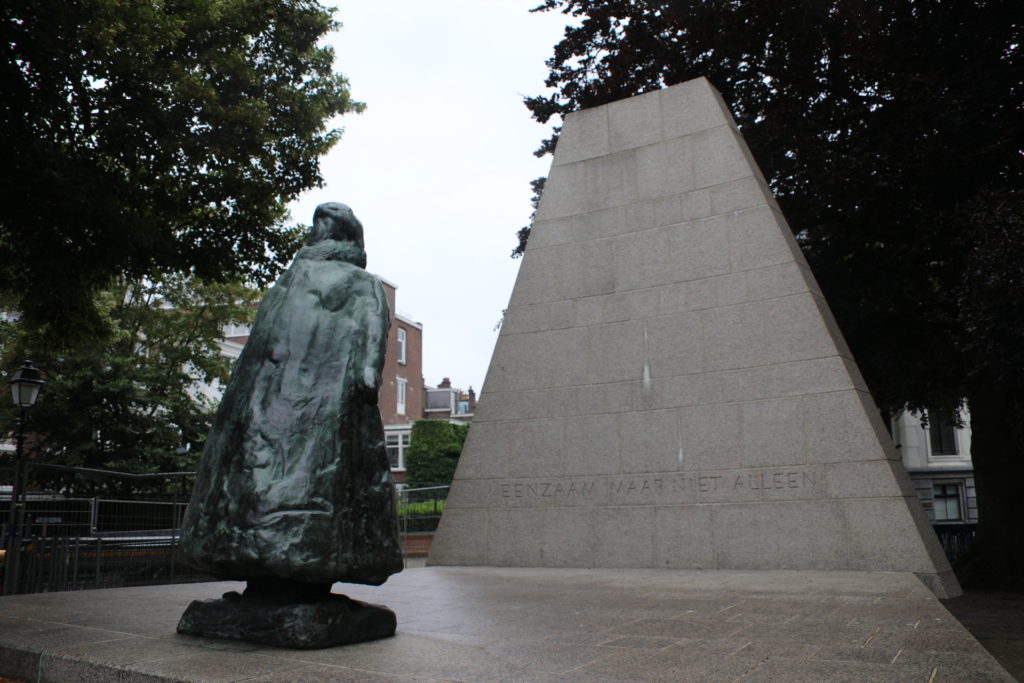
We first went to visit Escher in The Palace a permanent exhibition dedicated to the imaginative Dutch artist and mathematician M. C. Escher. The building was the former palace for Queen Emma.
I studied M. C. Escher for both of my pre-Calculus and History of Art projects during freshman year in high school, so I was familiar with his work. However, I was still fascinated by a deeper understanding of his life, intentions and meanings behind his work and his thoughts on art and life.


Escher is most famous for his so-called impossible constructions. He was constantly imaging new combinations to take the viewer by surprise, to “draw attention to something that is impossible.” In order to achieve this, he said, “there has to be a degree of mystery, but one that isn’t immediately apparent.” He even talked about using “trickery” to fool the viewers and create optical illusions. For example, in STILL LIFE AND STREET (1937), different spaces run seaminglessly into each other. The table in the foreground runs imperceptibly into another Italian street, confusing the brain with an impossible transition.

Another of my favorite is the three METAMORPHOSES series, which consist of a tessellated pattern undergoing a gradual metamorphosis. For example, a Dutch rural landscape can mutate into a pattern of white and black birds. The white birds fly into the darkness of night, while the black birds fly into the light of day. The work represents the combination of perpetual process and infinite number. The METAMORPHOSIS III is exhibited in a round panel, so that eternity and infinity are directly present in the physical experience of the work. What is matter, living or dead, if not the material of an eternal cycle of metamorphosis!

“A good bit of childish wonder is undoubtedly needed. And I’ve got plenty of that: wonder is the spice of life.” He wrote, “Perhaps all I am trying to do is express a sense of wonder and hence to evoke a sense of wonder in the viewer.”
We ate another typical Dutch sandwich lunch and had a brief lecture at the Dutch Language Union. At around 2pm, we visited the Mauritshuis, home to the best of Dutch and Flemish paintings from the Golden Age. The building itself has a beautifully historic and intimate interior, with its silken wall covering, golden chandeliers and monumental painted ceilings. It offers a rich collection of genre paintings by Jan Steen, landscapes by Jacob van Ruisdael and Johannes Vermeer, still life paintings by Adriaen Coorte and portraits by Frans Hals and Rubens, etc.


The most famous piece is probably Vermeer’s Girl with a Pearl Earring (1665), which beautifully depicts the softness of the girl’s face, as well as the glimmers of light on her moist lips and the shining pearl. This is a painting of an imaginary figure, called a “tronie.”

Rembrandt’s The Anatomy Lesson of Dr. Nicolaes portrayed the surgeons in action — since all of them are looking toward different directions. The great contrast between light and dark accentuates the dramatic effect of the scene.

Again, it is only by standing in front of the masterpieces and examining their details of the brushstrokes and colors closely, that one can understand the brilliancy and profundity of these pieces!

There is also a exhibition on the restoration of Rogier van der Weyden’s the Lamentation of Christ. The painting dates from around the 1460s and is the oldest work of art in the Mauritshuis museum. It has to be restored since the varnish has turned yellow in places. A short film unveiled to us what the restoration process is like. A comprehensive study of the study was required in order to choose a solvent and restore the varnish. The two female conservators examined the panel and the paint layers with stereomicroscope, UV, X-rays, Infrared, Macro-XRF, paint samples and Dendrochronology. It was amazing for me to see how the preservation of art has to be carried out in the most systematic and meticulous way!

After the museum closed at 5, we had dinner in a Italian restaurant and headed back to the hostel in Amsterdam to watch the semi-final World Cup game between France and Belgium. Belgium lost 1:0 to France. Think about it! We could have watched Belgium playing the final in Belgium!
2018.7.11 Day 11: Leiden, Leiden University, City Tour, flea markets, Rijksmuseum Boerhaave
Today we took a 45-min train to Leiden, one of Europe’s most prominent scientific centers since four centuries ago. A typical university city, university buildings are scattered throughout the city. Students from all over the world come here for the pursuit of knowledge, giving the city a bustling and international vibe. Countless scientific discoveries have been made here, giving rise to Leiden’s motto: ‘City of Discoveries.’ Leiden is also a city with a rich cultural heritage in the arts. One of the best Dutch Golden Age painters, Rembrandt, was born and educated in Leiden.



We first walked to Leiden University, the oldest university of the Netherlands and one of Europe’s top universities. It has one of the prettiest campus I’ve ever seen!
A lecturer in Dutch Studies here gave us a brief talk about the university and later a city tour.

The university was founded in 1575 by William of Orange, leader of the Dutch Revolt in the Eighty Years’ War. Many Royal Family members, such as Queen Beatrix and King Willem-Alexander, are former students here. During the Dutch Golden Age, prominent scholars from all over Europe came to Leiden in the Dutch Republic for its intellectual tolerance.
Then we walked upstairs to the Sweatbox. There has been a longtime tradition that students inscribe their names on the walls of the room after having successfully graduated. The drawings on the walls date from 1865 and are by Victor de Stuers. He also painted the text taken from Dante, which means “abandon all hope, ye who enter here.” Our tour guide explained that this is because students used to wait for the results of their grades here.



The Senate Chamber is a room where portraits of Leiden’s most eminent scholars here are hanging on the walls. With more than four centuries of university history, the portrait of the first female professor only appeared in 1929. However, the university is now breaking the tradition of a male stronghold in the room by putting up the portraits of fourteen female professors.

There is also a room where all professors keep their black robes for special events. On the glass in front of a special robe, there is a quote from a famous speech about freedom and opposition to dictatorship, given by the owner of this robe.

Outside of the building is a beautiful botanical garden and a huge glasshouse. Hortus botanicus Leiden is the oldest garden in the country, also the scene to many marriage proposals! There is a Japanese poem written vertically on the wall of a building in front of the garden.

We also took a walk on the Van der Werff Park and went on top of a small tower. There were always black crows around and on top of us, fluttering their wings against the leaves. They all turned their heads in a mechanical way and stared at us, as if monitoring our activities with suspicion. Suddenly, the church clock struck at 12. At the end of the tour, the lady from Leiden said to us: “You can read as many books as you like. But the feelings… You can only feel the city when you are physically here.”


At noon, my friends and I went to a small pasta restaurant for lunch. After that, we walked along the main canal. Every Wednesday and Saturday this area around the Nieuwe Rijn changes into a large market. Today is Wednesday. The quietness in the morning had been replaced then by a motley collection of stalls and a bustling crowd. Vegetables, fish, fruit, flowers, clothes, jewelries or exotic spices from everywhere of the world… The mixed combination of local and foreign colors made the market into a large-scale festive gathering. The smell of stroop waffles made me drool.

My favorite part of the city is the poems you can see written on almost every building, famous or obscure, of all kinds of languages and genres. The most memorable one for me is a poem by E. E. Cummings: “…into the street of the sky light walks scattering poems…” Some written in swirling lines and some highlighted with saturated colors, the creative typography of these poems themselves is also poetry.



In the afternoon, we went to Rijksmuseum Boerhaave, a museum of the history of science and medicine. Modern scientific medical research and teaching started in the early 18th century in Leiden with Boerhaave, a Dutch scientist famous for his teaching at Leiden and received many brilliant students from all over Europe. He separated the valuable aspects of both old and new medical insights from the fallacies, creating a new field of medicine.



The museum is home to a large collection of historical scientific instruments and documents from all disciplines, including the a apparatus with which helium was first liquefied in Leiden. Every exhibition area has its own interactive devices for providing a more intimate and exciting learning experience.
At dinner, we went to a Dutch pancake restaurant, called Oudt Leyden. I ordered a savory one with bacon, egg and cheese. The portion was huge for one, but I thought it was pretty tasty and almost finished mine. I thought it tastes a bit like the big Chinese pancake, salty and a bit greasy. Three guys were sitting on a table near us. At one point I suddenly heard one of the guys say: “Let’s talk about freedom.”


In order to observe these places more intimately, toward the end of days I always leave some time to walk through the cities by myself. Anywhere I go, I feel as if I am always floating inside a massive dream, but never part of it. The whole scene, with its epicurean atmosphere, seems exquisitely constructed. I, with my black hair and yellow skin—among all these tall, slim and blond Europeans with blue eyes—have involuntarily become an inharmonious note of the western classical melody. Some locals seem quite indifferent, if not condescending. And the never-caring-to-slow-down bikers intimidate me.

I’m too used to the diversity in America. It is only after I came to Europe that I started to appreciate the relatively intimate relationship I, a foreigner, have developed with America, where I’ve already spent five years studying!
2018.7.12
Day 12: Jewish Historical Museum, Resistance Museum, Anne Frank House
In the morning lecture, we learned about the history of the Netherlands during WWII, with a focus on the Nazi occupation and the Holocaust.
In the afternoon, we visited the Jewish Historical Museum, where we learned more about the history of the Jews in the Netherlands from the 17th century to the present.
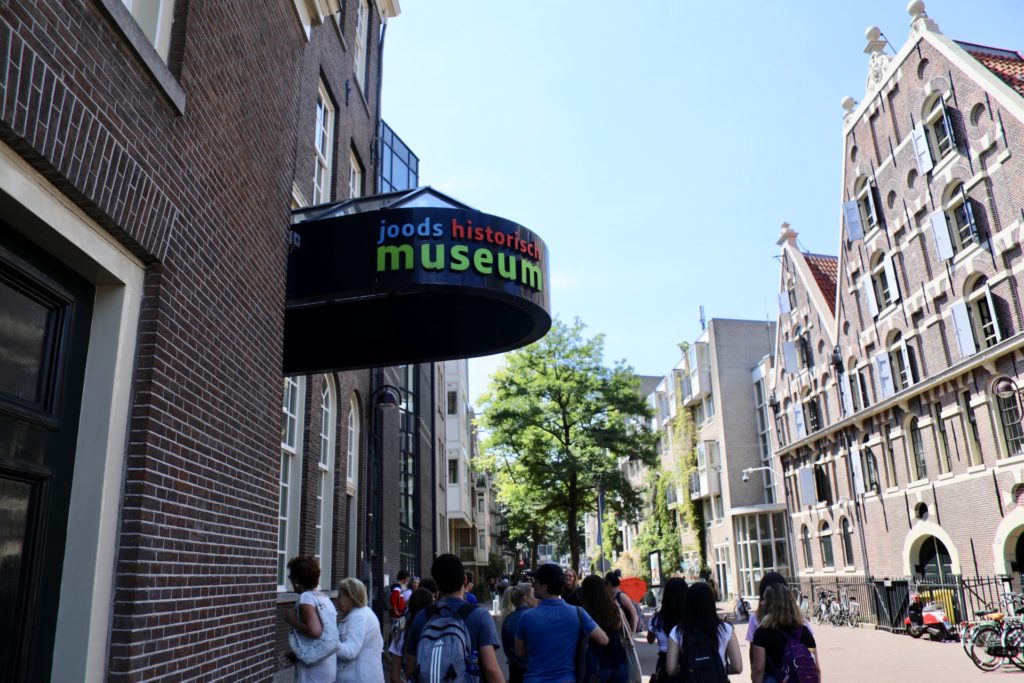
In the 17th century, the Dutch Republic was attractive to the Jews due to its economic success and a relatively tolerant religious environment. They were able to practice their religion here in relative freedom, without having to wear distinguishing marks or live in ghettos. By the start of the 18th century, Amsterdam had developed into the biggest and most important Jewish city in the world. Jewish scholars came to this metropolis from all over the world and made Amsterdam “the unrivalled center of Hebrew and Yiddish book printing.” Non-Jewish travelers were shocked by the Portuguese Synagogue (1675). There was no other city in the world where synagogues of this size existed!
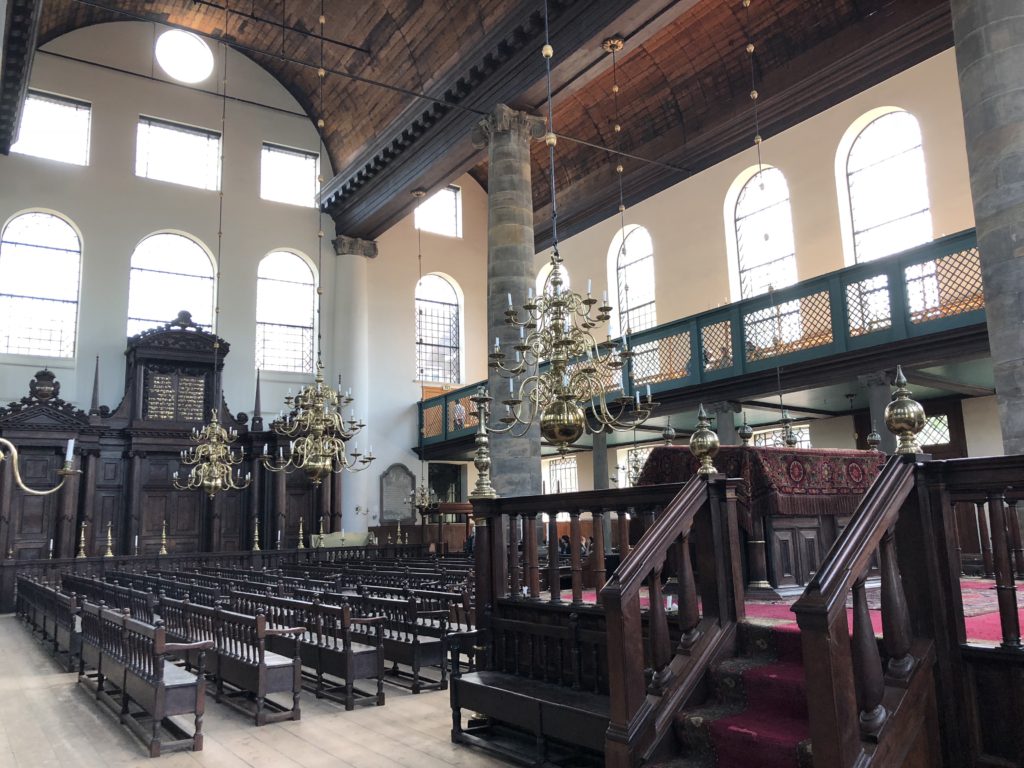
During the 19th century, the Dutch Jews were transformed from tolerated outsiders into fellow countrymen. The vast majority of Jews eventually were integrated into the society. The upper classes seized at the opportunities offered by the legal emancipation and soon became leaders in science, politics and art. The lower classes also experienced slow improvements of income and living conditions.
However, WWII put an end to the emancipation dream for the Jews. On May 10, 1940, German troops marched into the Netherlands. In the process of hunting down the Jews with the Jewish identity cards and maps indicating where the Jews live, the Germans took advantage of the highly efficient Dutch registration system and the accommodative stance of the Dutch masses.
Around 25,000 Jews went into hiding during WWII, with the help of non-Jewish acquaintances or resistance organizations. Three quarters of the Jews were deported to concentration camps and killed by the Nazis. Many were sent to the Westerbork transit camp.
After being liberated in 1945, around 30,000 Jews survived the war. Only about 5,200 Jews returned from the camps. Upon returning to the Netherlands, they met with a cold and bureaucratic reception, scarcely receiving any support in rebuilding their lives. The survivors often had their relatives murdered and possessions stolen. The Dutch population, including the government, took little interest in the plight of these Jewish survivors, as they had to cope with its own distress and poverty.
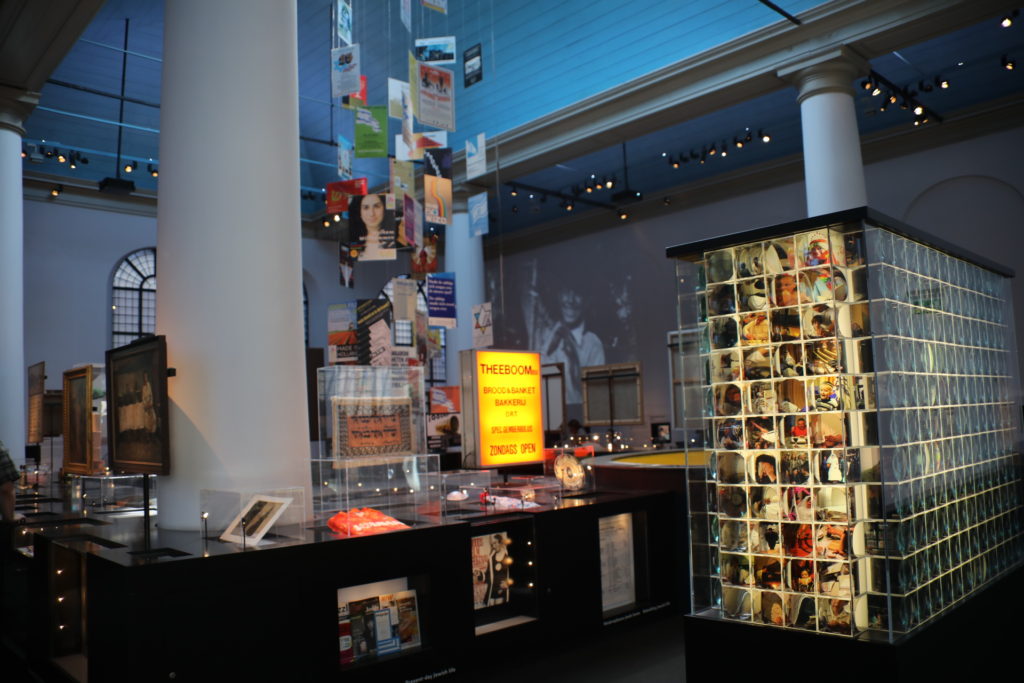
After the war, many Jews lost their hope in the Netherlands or even the religion itself. Many of them moved to other countries. Yet the Jewish communities and organizations were also re-established. Over time, the Dutch population had a better understanding of the events of the war and its painful impact on the Jews. The better acknowledgement gave rise to a deep sense of shame about the level of Dutch cooperation in the three quarters of murdered Dutch Jews.
In 1973, an Act of Parliament finally granted financial support to the victims of WWII. Since then, the Netherlands has been rebuilding a strong and multifaceted Jewish community. Today, around 43,000 Jews live in the Netherlands.
What I really liked about the Jewish Historical Museum are the interviews of Jewish survivors, where you can find in the big exhibition room upstairs. These interviews gave the non-Jewish people like me a more intimate perspective on the unimaginable suffering of the Jews during WWII and how they managed to live after the war.
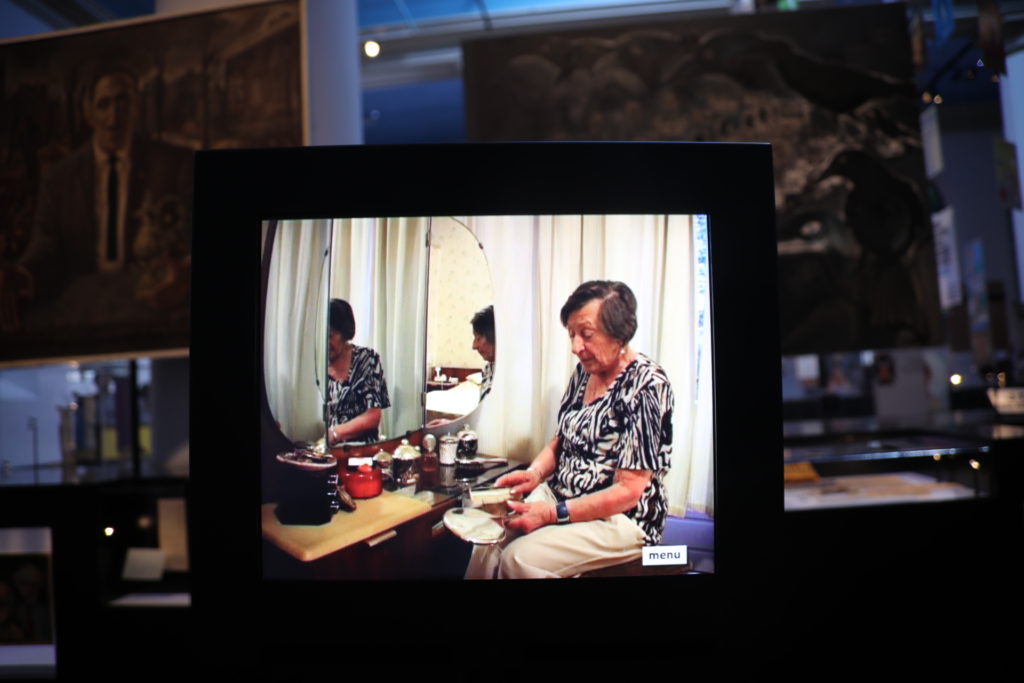
Next we visited the Resistance Museum, which tells the story of the Dutch people in World War II. It is chosen as the best historical museum of the Netherlands.
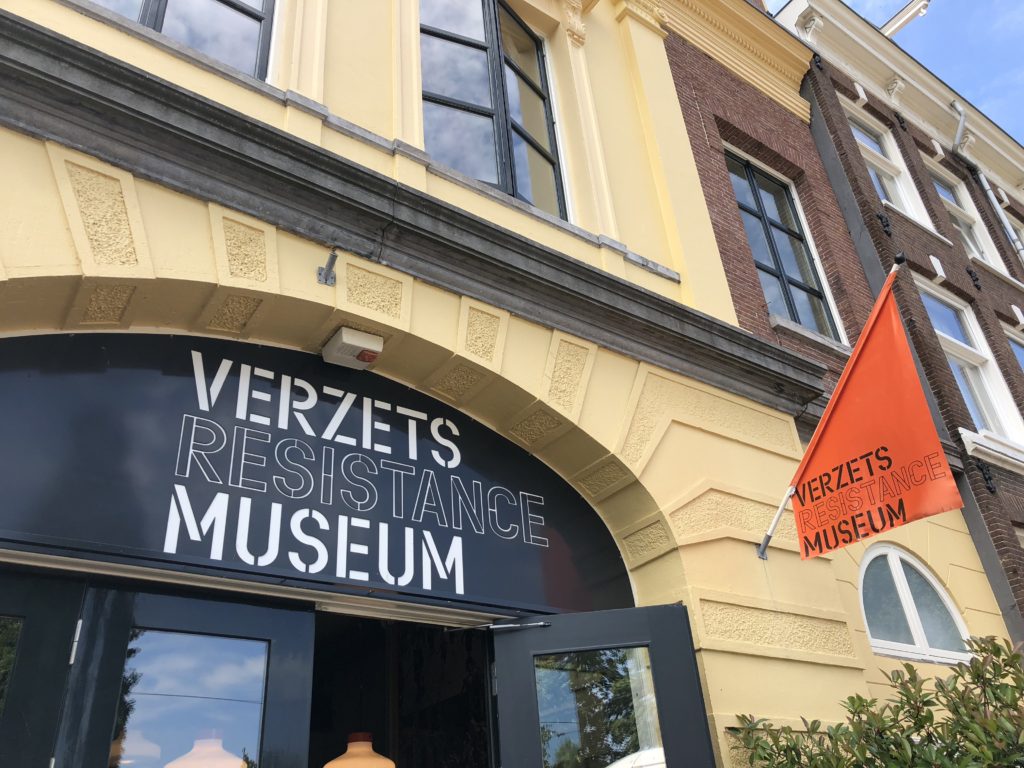
The permanent exhibition recreates the atmosphere of the streets of Amsterdam during the German occupation with photographs, old posters and documents, personal letters, films and sounds. But I spent most of my time in the Junior Museum, which centers on the stories of four Jewish children during the war. They are Eva, Henk, Jan and Nelly. Stories of four different themes — persecution, resistance, collaboration and everyday life — are told through the voices of these four children respectively. In the end, there is a room where visitors can watch real interviews of these four people as they reflected upon their own wartime memories.
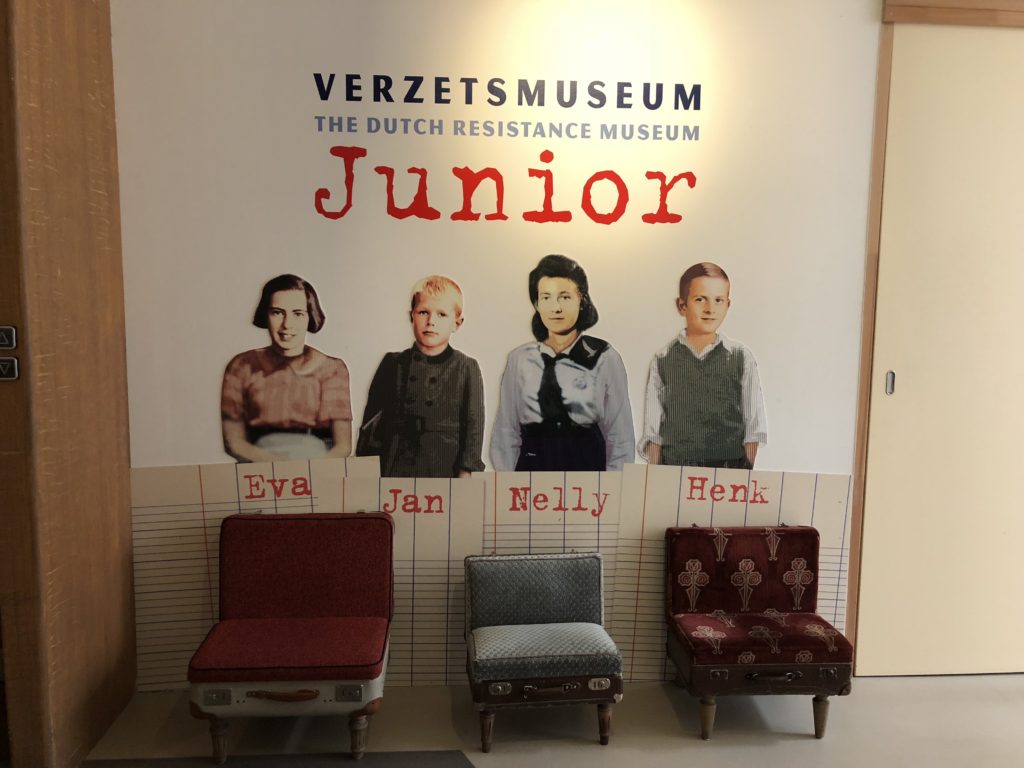
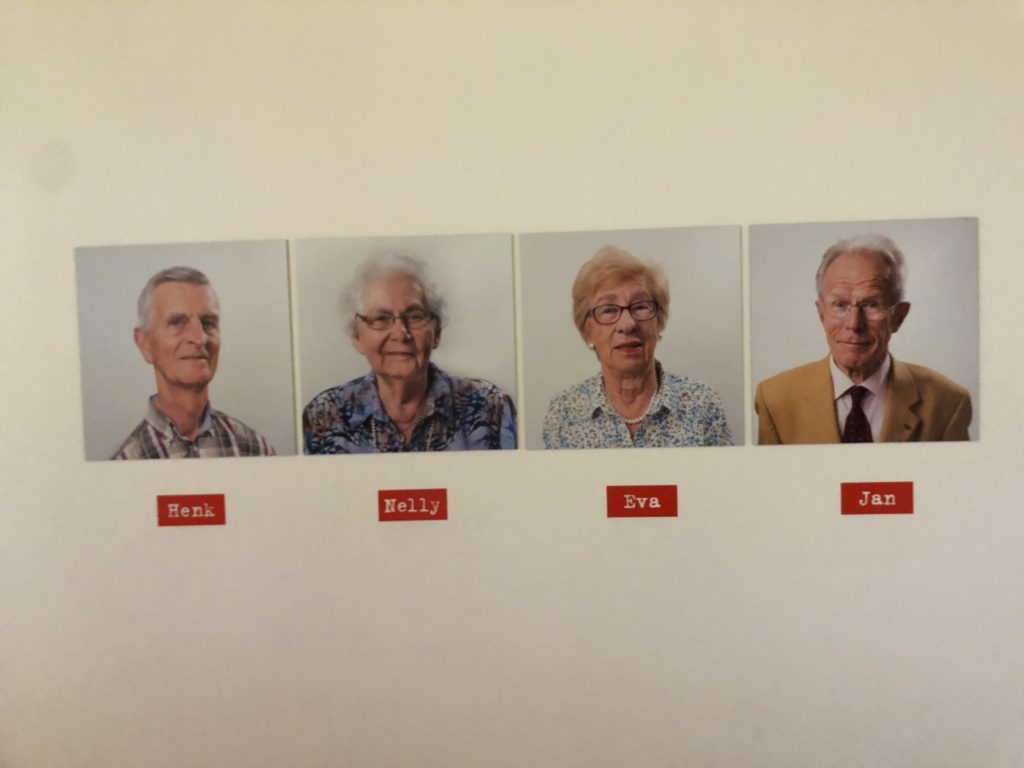
For me, the most memorable characters are Jan and Nelly.
Jan is the son of a Resistance leader. He was proud of his father, but at the same time scared of what his father was doing. He was constantly worried that someday his father would be arrested by the Germans. Unfortunately, his father did get arrested. Jan had to leave home by himself and live with a man. He often felt lonely. He moved again and again, never letting anybody know his real identity. He imagined himself to be a brave Indian, riding alone toward the sunset yonder. After the liberation, he reunited with his father. He wanted to go to a missionary school and teach faith to others in plight.
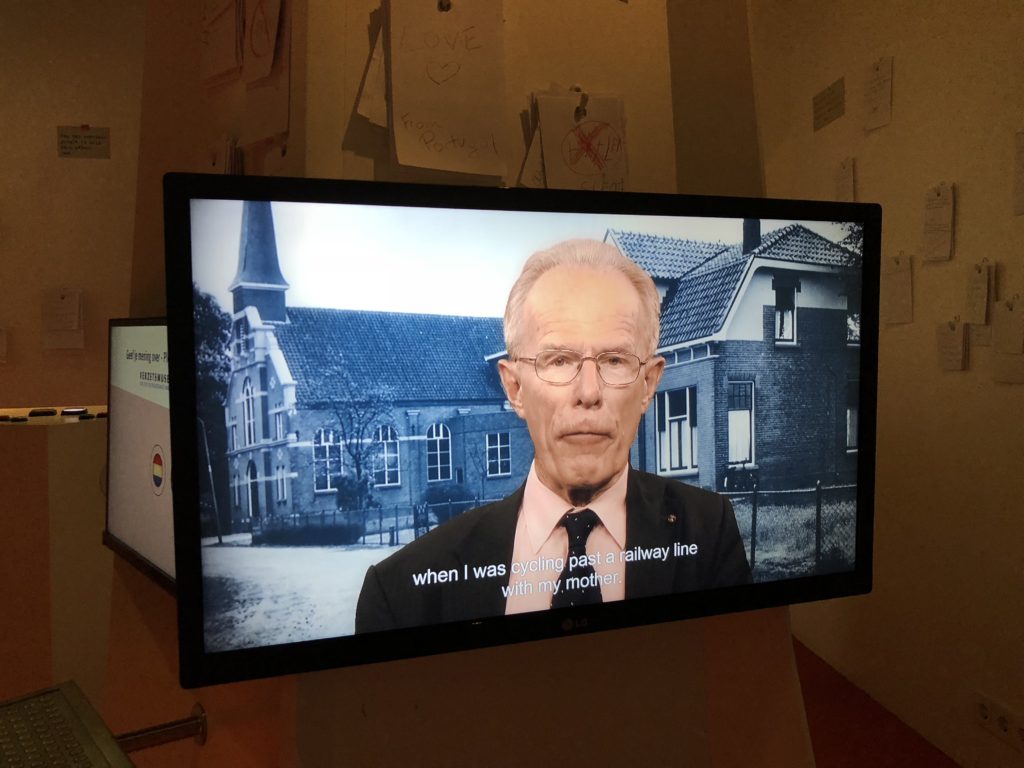
In the real interview, Jan has become a silver-haired old man with a firm look in the eyes. He talks about, with a firm and dignified voice, the most important words his father had taught him. “Never hesitate to help others,” He says. “Because helping others is our duty.”
Nelly, on the other hand, is the daughter of a Dutch Nazi leader. Her father was an admirer for Hitler and believed that the German Nazi Party can liberate the Netherlands. When Germany lost the war, her family got arrested. The guards were very angry with them, hitting them and cutting their hairs and giving them little food. It was also only then did they realize the Jews sent to camps had been tortured and murdered. Even after they were released after a few years, no one talked to them. People considered them traitors.
To my surprise, Nelly says that she had no regrets in the interview. She doesn’t blame her family for what they did because things always happened in one way or another. She thinks they are not guilty, because they did not know what was happening to the Jews at that time. But she also says that she wish there can no be more war, as it is a terrible nightmare.
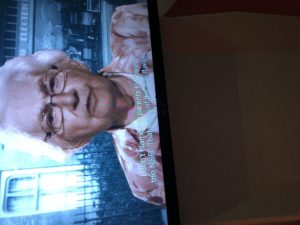
As an outsider to this piece of history, I don’t want to impose my judgment on the moral character of any victims, no matter which stance they took during the war. However, I think what matters is an awareness: we as outsiders can never understand, or even imagine, what those people lived through and why they made their decisions under what circumstances; but it is necessary for us to be aware that terrible things have been happening to people and all of us cannot be exempted from any part of the history. Because we are all one kind, living under the same sky. It is not history that repeats itself. It is the mankind that keeps doing the same things, only under the disguise of different pretexts.
At the end of the day, we visited the Anne Frank House. Anne Frank was a German Jewish girl that moved to Amsterdam with her family during WWII and had to go into hiding later to escape from the Nazis. Together with seven others, she hid in what she called “The Secret Annex” at Prinsengracht 263 in Amsterdam. It was also in here that she wrote her diary, which accounts for everyday life in the hiding place, the dynamic among the eight people, and her own incredible growth under the extreme condition. After more than two years in hiding they were betrayed and deported to different concentration camps. Anne’s father, Otto Frank, is the only one of the eight to survive. He published Anne’s diary and kept campaigning for human rights until his death.
I read her diary right before this trip (and for this trip). It touched something deep inside me. I felt so amazed, but also sad, by how she was forced to transform quickly from a flippant young girl, to a strong and mature young woman with exceptional insights of the world and herself. “Who would ever think that so much went on in the soul of a young girl?” She exclaimed in the diary herself.
In the museum, I followed the line and climbed up the steep stairs slowly to the Secret Annex. Everyone was silent. One by one I looked at the old celebrity posters, the Royal Family portraits, the pencil marks on the wall — all of which she had described so vividly in writing. And I saw the attic from below, where she and Peter — the only boy in the hiding place — put their arms around each other, supported and opened up to each other in a touching relationship.
Right before I left the Secret Annex, I heard the church clock struck outside. I walked out to the museum hall and looked outside through the glass. It was the lofty church and its clock that Anne had described. Several times she wrote that the chiming of the clock every quarter-hour gave her great comfort. “We’ve all been a little confused this past week because our dearly beloved Westertoren bells have been carted off to be melted down for the war, so we have no idea of the exact time, either night or day.” She wrote.
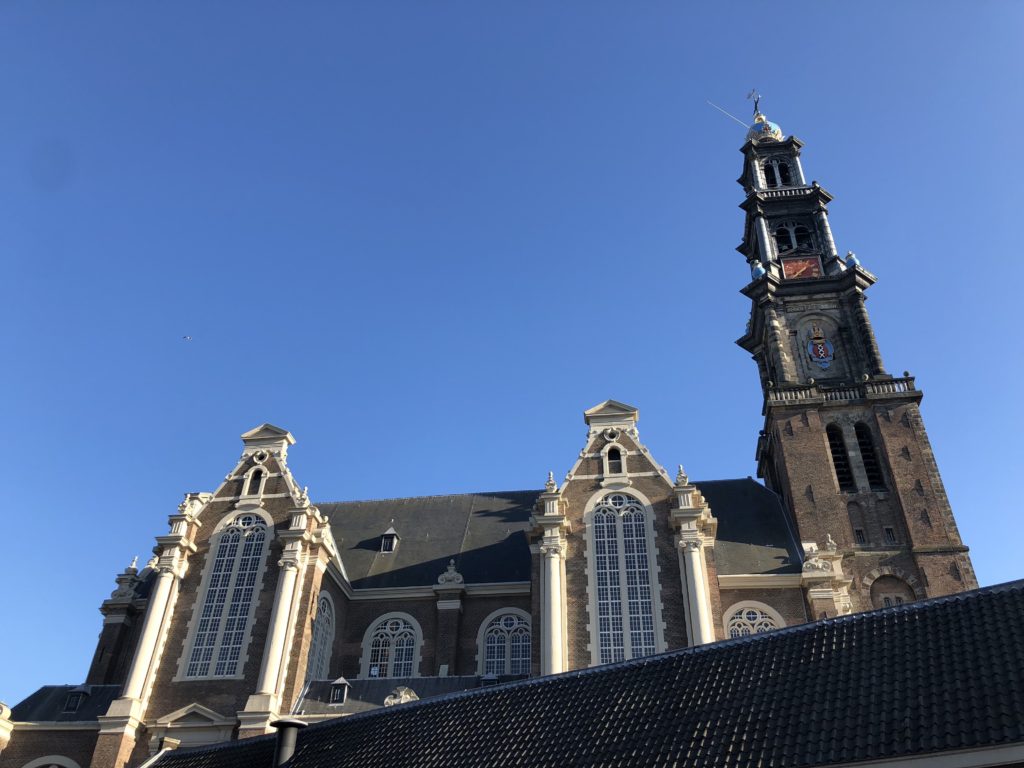
As I walked out of the museum by myself, I was dazzled by the bright light of the setting sun. The easiness and freshness outside contrasted greatly with the stuffiness and dimness of the yellow light inside the narrow rooms. I was terrified by this contrast, by how different each person’s life becomes even under the same sky, by how apathetic and ignorant one person can become toward another’s life. And I’m only a visitor and a complete outsider! How did Anne feel while she looked out of the window and saw the blue sky, smelt the fresh air and heard laughter from people living normal lives outside?
But it is inevitable that I soon lifted myself up from the heaviness of human heart, for no one truly suffers for others’ sorrow in a completely different time. I am aware of this while I made joke and laughed with my friends half an hour later. But what else can I do? Instead of being weighed down by the heaviness of history, I think we should inherit the strong and optimistic spirit from Anne. We should always keep our hopes up and dream boldly to make a change to our world, as Anne did.
“I don’t think of all the misery, but of the beauty that still remains.” She wrote.
At night, I went to dinner with two Chinese and one Singaporean friends in an Indian restaurant nearby, called the Koh-I-Noor. While satisfying our hungry bodies the delicious chicken masala, we talked about things that we were not happy with. For example, we talked about the young generation in China and some politics, which I will not talk about too much here. One of the girls said she is very cynical. Another said she is an idealist. And that’s probably what we all are: the cynical idealists!
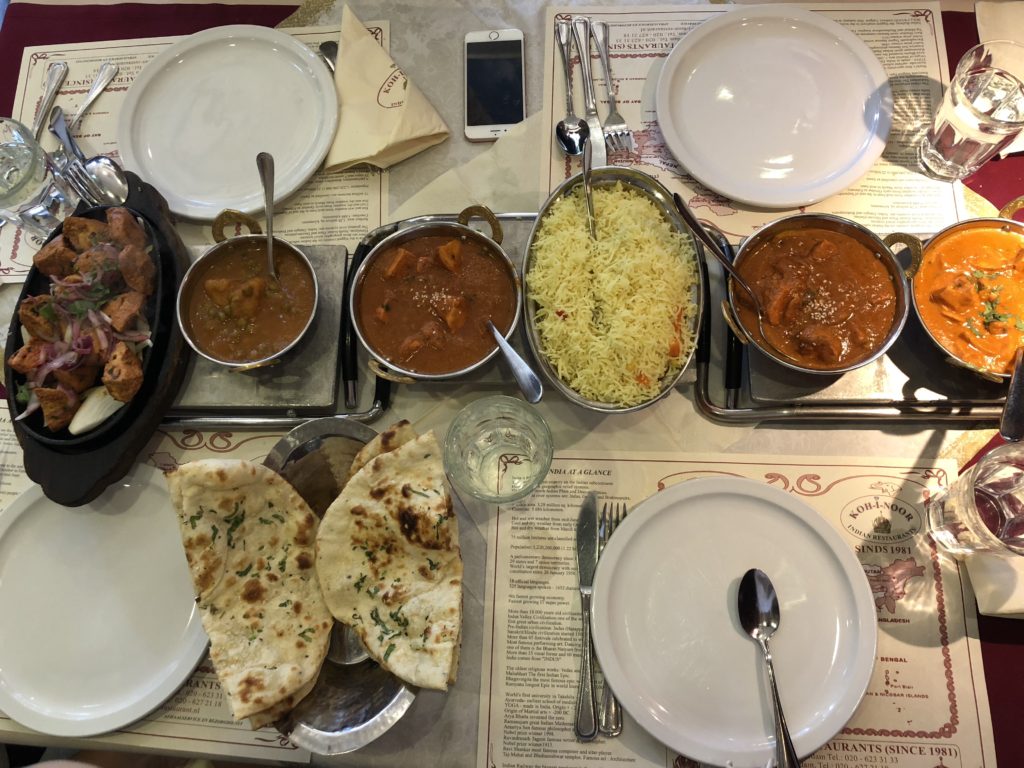
2018.7.13
Day 13: Rotterdam, Post-war Architecture, The (second-to-the) Last Supper in Holland and Time Spent by Myself
We took a train to Rotterdam in the morning. Rotterdam is Europe’s largest port. The near-complete destruction of the city center, after the WWII Rotterdam Blitz by the Nazis, has resulted in a varied, modern and completely unique architectural landscape.
Our city tour guides are our lecturer’s friend, a couple that met each other in Leiden University and has been married for fourteen years (the wife told me later during the tour). She also told us that, her grandma returned to the city after the bombing in 1940, and only found her way back home by following the tram trails. There was almost nothing left above the ground.
I marveled at the completely different architecture style of each building, and the fact that somehow they managed to fit together congruously in the cityscape. Every building has a unique nickname given by the locals. In fact, the locals only remember the buildings by their creative nicknames.
For example, there is the Swimming pool.

There is also the Pencil.
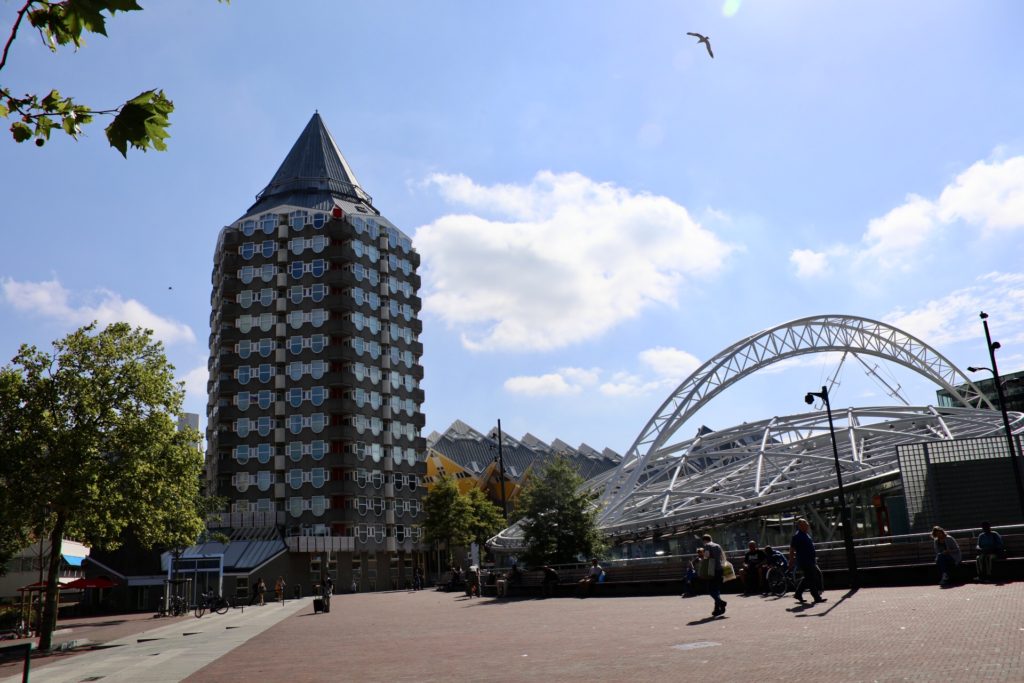
And also the famous cube houses, nicknamed the forest. These are a set of tilted cube houses designed by Dutch architect Piet Blom. His design represents a forest within a city, where each house represents a tree. The idea is to optimize the space as a house to a better distribution of the rooms inside. Walking into the “forest,” I saw many fashionable young elites sitting downstairs, smoking and immersed in their own worlds.
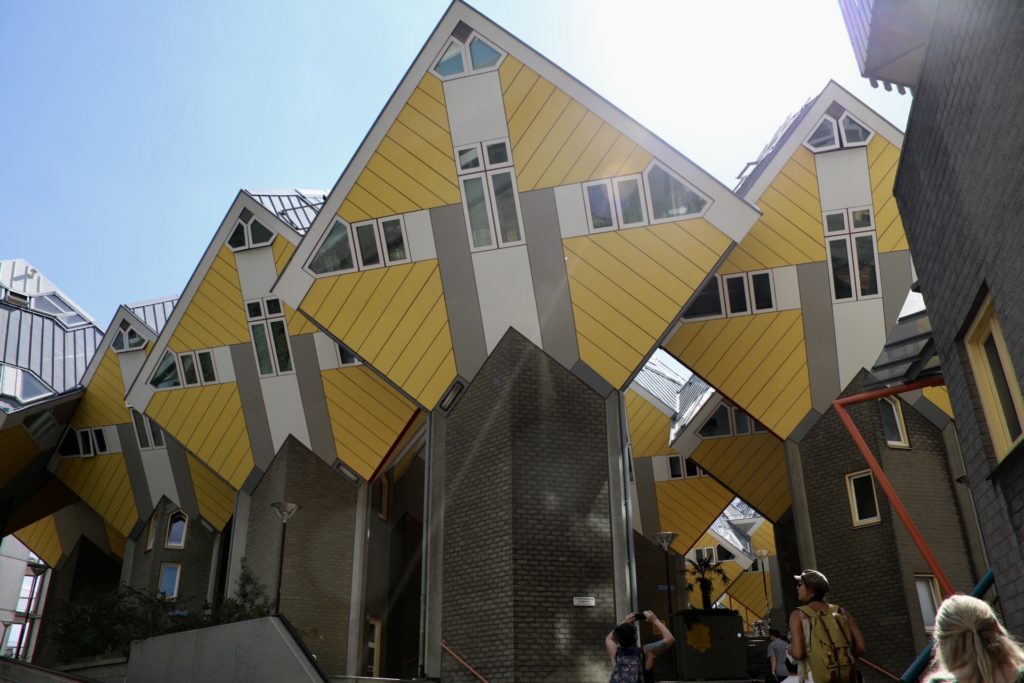
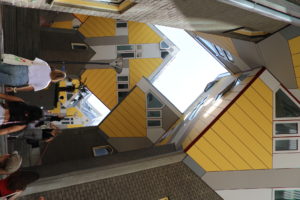
A friendly side note: if you’re looking for a place to get ice cream or food in general, Markthal is THE place to go. With an archwise structure and a glass façade on both sides, Markthal is both a residential and an official building with a market hall underneath.
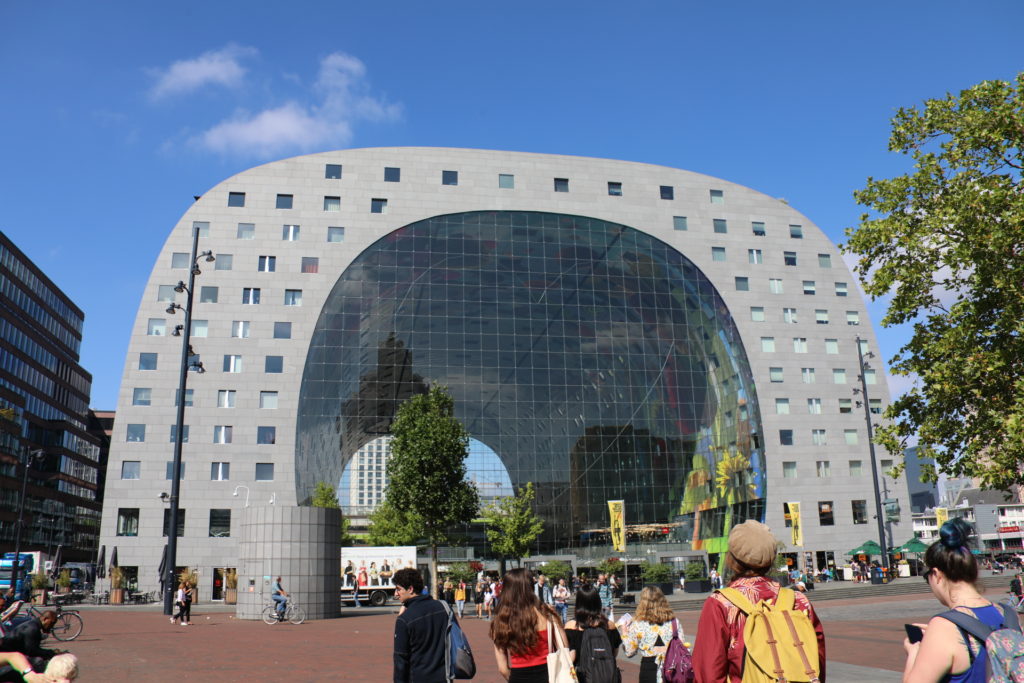
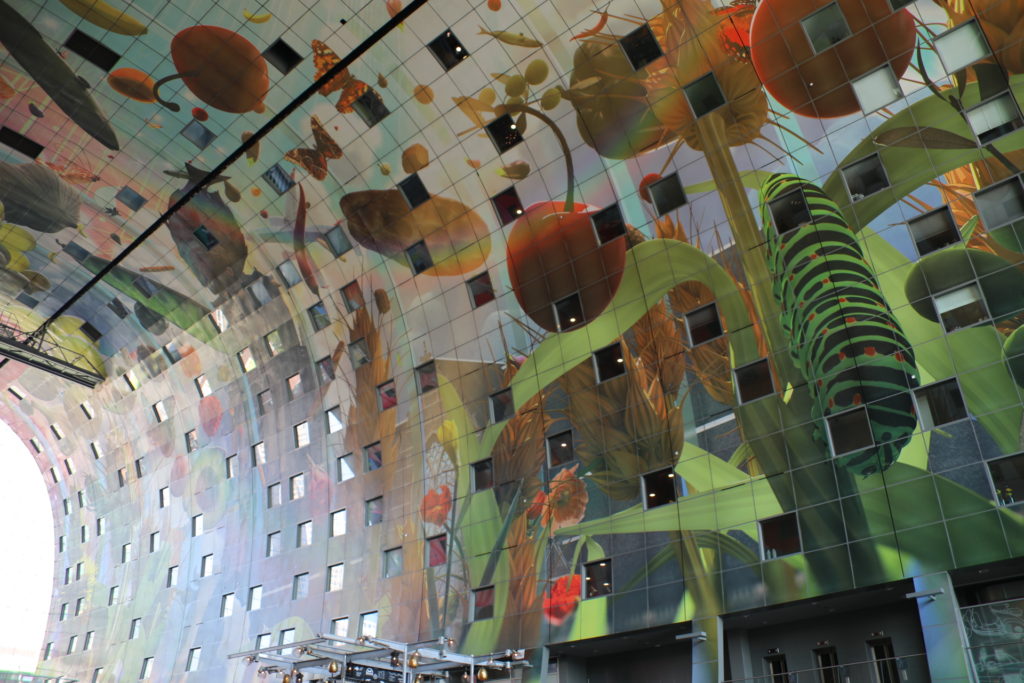
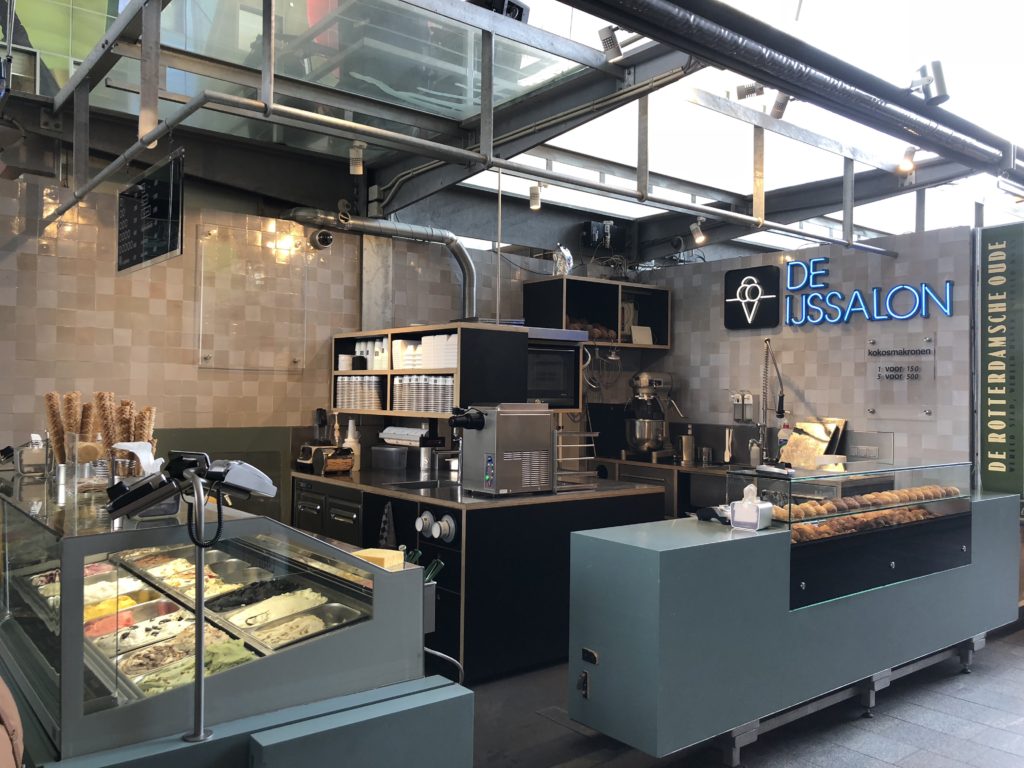
We took watertaxi back to the other side of the river and walked to the Rotterdam Centraal Station. From there we took a train back to Amsterdam in the early afternoon.
We’re leaving for Belgium on Sunday. So today is our final weekday in the Netherlands and also the last day with our Dutch female lecturer, E. Together we walked to The Pancake Bakery and had Dutch pancakes for dinner.
I liked everyone in my class and already became good friends with many of them. But today I felt very tired and remained rather quiet. Before our food came, I had to go outside by myself and took a cigarette break from the boisterous dinner inside.
I sat on a wooden bench and watched the glittering canal river under the setting sun. I could finally take a deep breath of the fresh air and relax. In fact, I have always been rushing from places to places, visiting one museum after another, socializing with different groups of people, and forcing myself to keep taking pictures and jotting down notes. I wanted to take the advantage of this trip to explore everything and not to miss out on anything. I was always the last one to go to bed and the first one up in the morning. I barely ever had enough sleep.

It was not until then, under the setting sun, that I had the chance to sit down by myself. It was not until that I realized how much I missed the solitude and peacefulness that one must have with oneself at the end of each day.
I looked around, and realized that there were actually a lot of loners and smokers also sitting by themselves and enjoying solitude. Quiet and relaxed inside — this was the feeling I was searching for since day one, when I saw all those people lying on the grass in the Vondelpark. It was only by doing nothing that I finally found what I wanted.
After dinner, I left the group and walked back by myself. The rest of my night was lonely yet beautiful.
As I walked by the Vondelpark, a hippy-looking young man hanging on a tree called me “Japanese” and yelled at me through the iron bars. I gave him a middle finger.
2018.7.14
Day 14 (Last day in NL): Moco Museum, Museum of Prostitution, Red Light District Revisited Alone (peep show and sex show)
Today is our last day in Amsterdam. Tomorrow morning we will go to Antwerp in Belgium by bus.
Just like last night, I was tired of being around people all the time. I woke up early and left by myself. Listening to music while walking alone on the street is one of my favorite things to do. I strode confidently across the streets, feeling lighter and easier than ever!
I went to the Rijksmuseum again to finish what I didn’t get to see the previous time. I walked through the Gallery of Honor and looked at Rembrandt’s and Vermeer’s masterpieces once again.
Then I visited the nearby Moco Museum (Modern Contemporary Museum). The featured artist now is Banksy, a British artist specialized in street art. Banksy started as a graffiti artist and his works are often humorous and political, containing great connotations that completely change the public’s view on war, government, human rights and freedom.
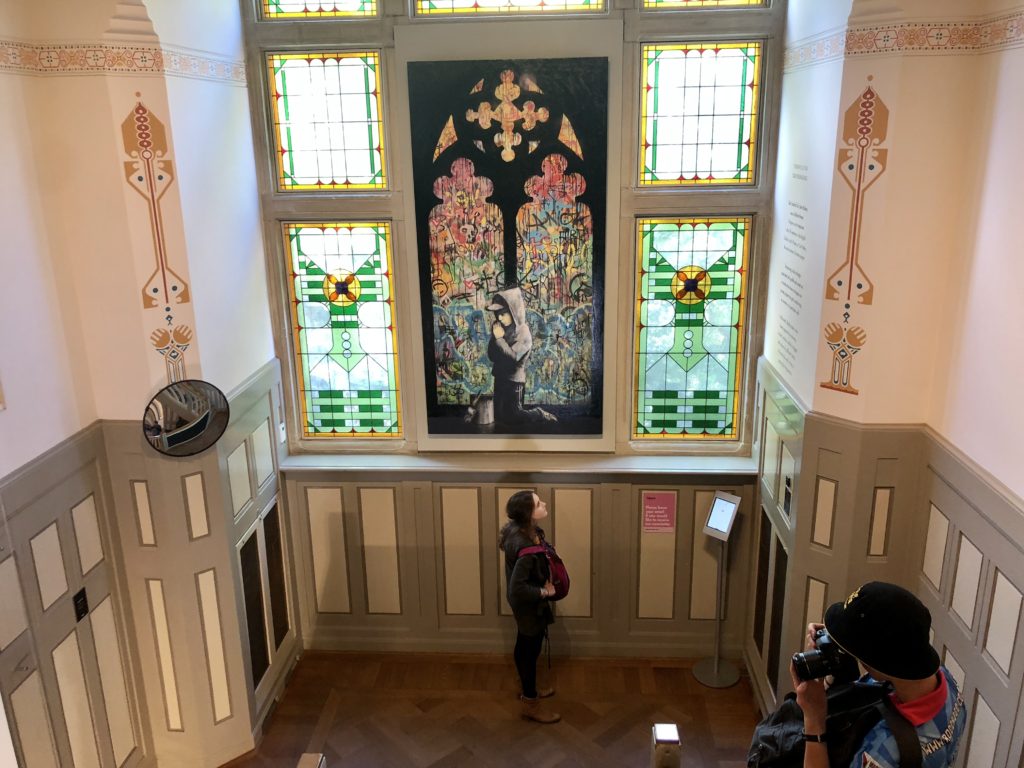
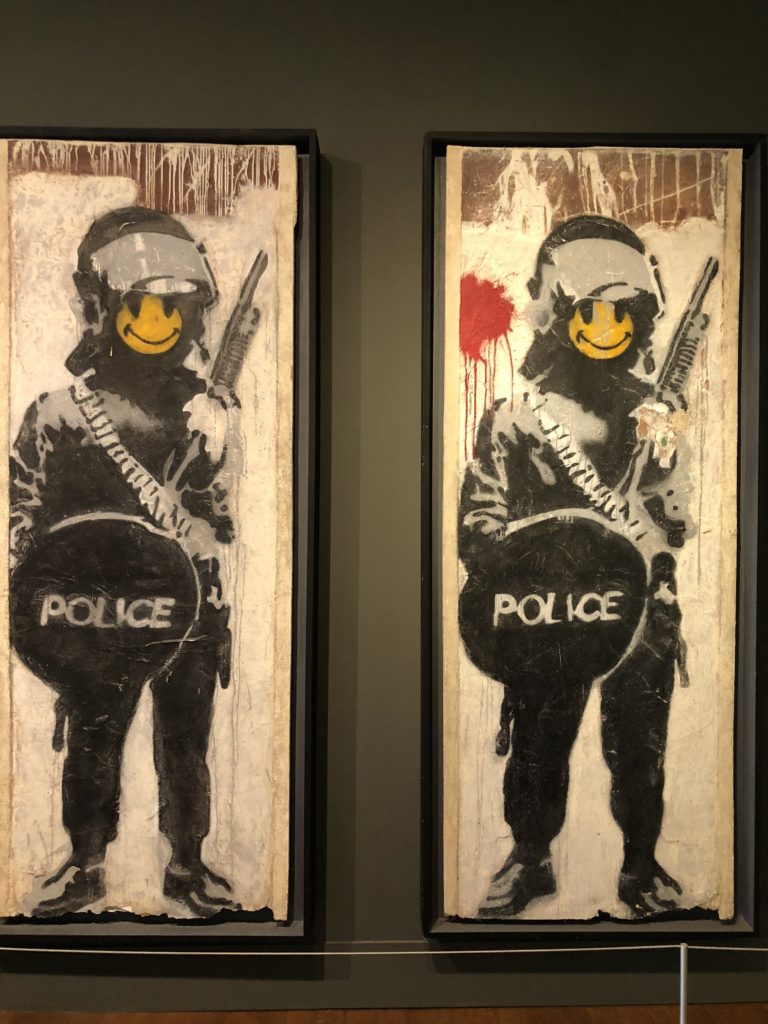
In ‘The Girl with Balloon’ (2002), an innocent little girl is reaching for a red heart-shaped balloon just beyond her grasp. The work evokes the idea that hope is essential, as it gives people the power and motivation to live through the difficult times and pursue happiness.

‘Flower Thrower/Love is in the air’ (2006) is another of my favorite. The iconic stencil illustration depicts a man that appears to be involved in a riot. He wears a handkerchief and backwards cap, paradoxically armed with a bouquet of flowers. Everything is done in black and white, except for the colorful flowers. In this piece, the flowers, replacing an expected weapon, symbolizes peace and hope instead of destruction.
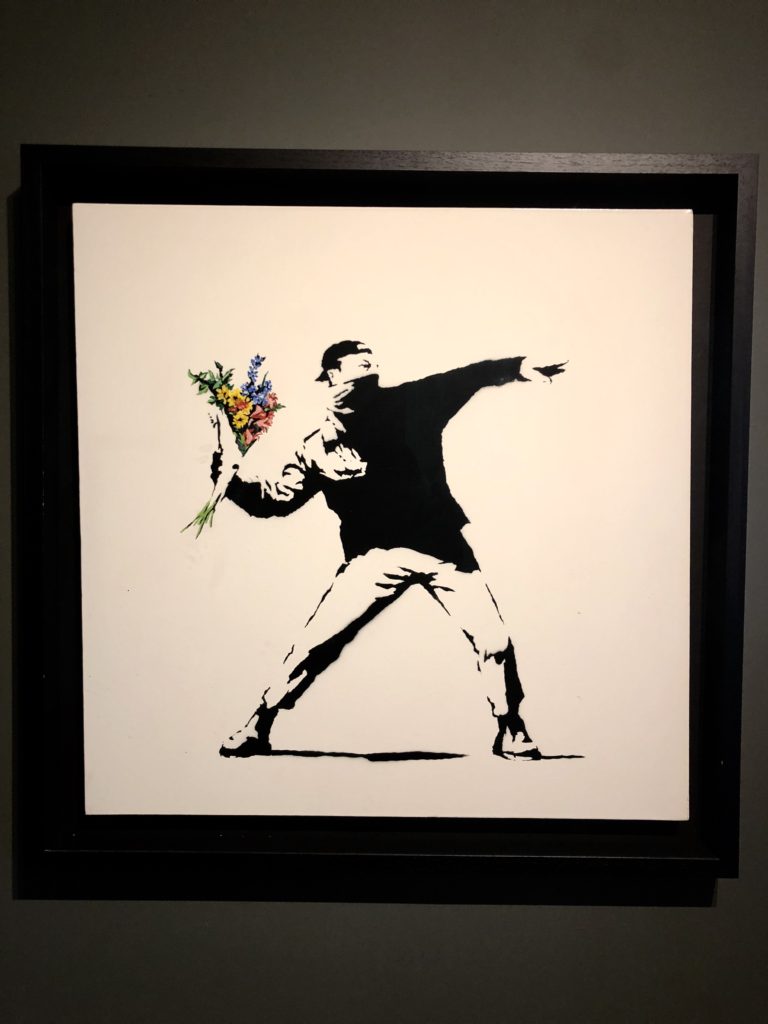
After the museum and lunch in a Japanese restaurant, I went back to my room and started editing videos for vlog. One of my roommates came back. We headed to an Indian restaurant, Sherpa, for dinner. We talked quite a lot, about personal life, about art, about sex. She told me she really likes Amsterdam for its openness and honesty toward sex, prostitution, or soft drugs. She said she loves how Amsterdam demystifies these so-called taboo subjects. She suggested that I should go check out Museum of Prostitution and sex shows on the Red Light District.
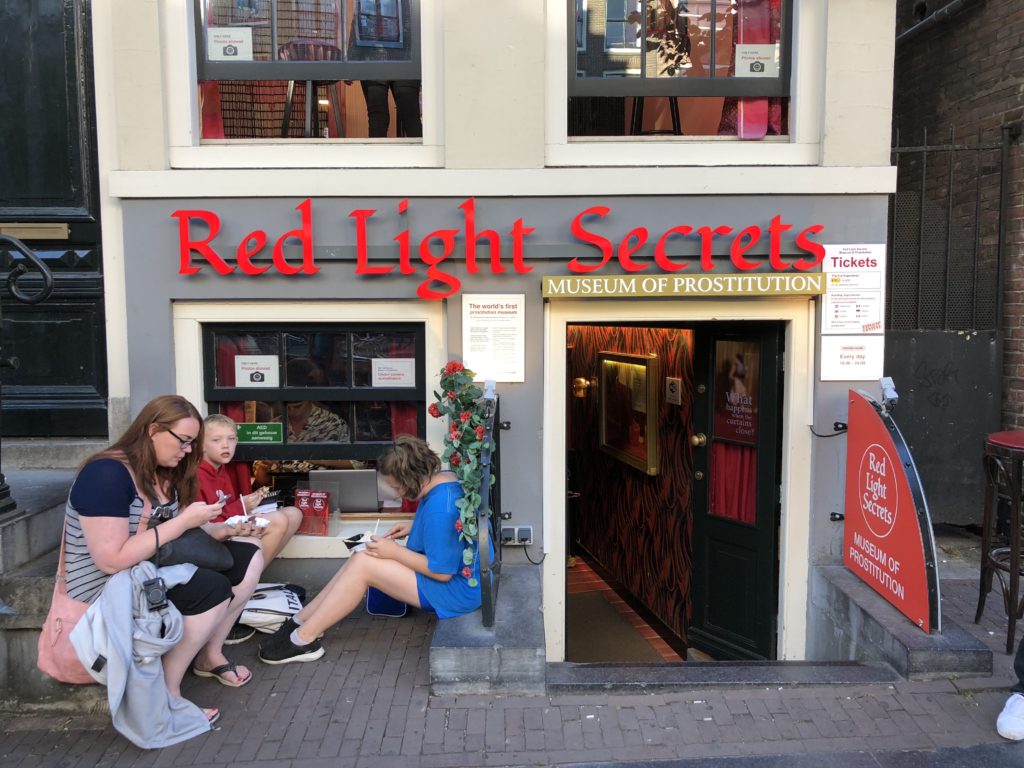
To be honest, visiting the Red Light District alone as an Asian girl completely changed my views on prostitution and sex. The Museum of Prostitution demystified prostitution for me. Prostitutes are proud, confident women just like performers on TV shows. While the sex show taught me that sex and love really can be, and should be two separate things. There is sex with love, and there is sex without. There really is no reason to look down upon sex that exists only as a result of pure pleasure, because after all it is something as usual as dancing with a partner. It is merely an interactive form of expression.

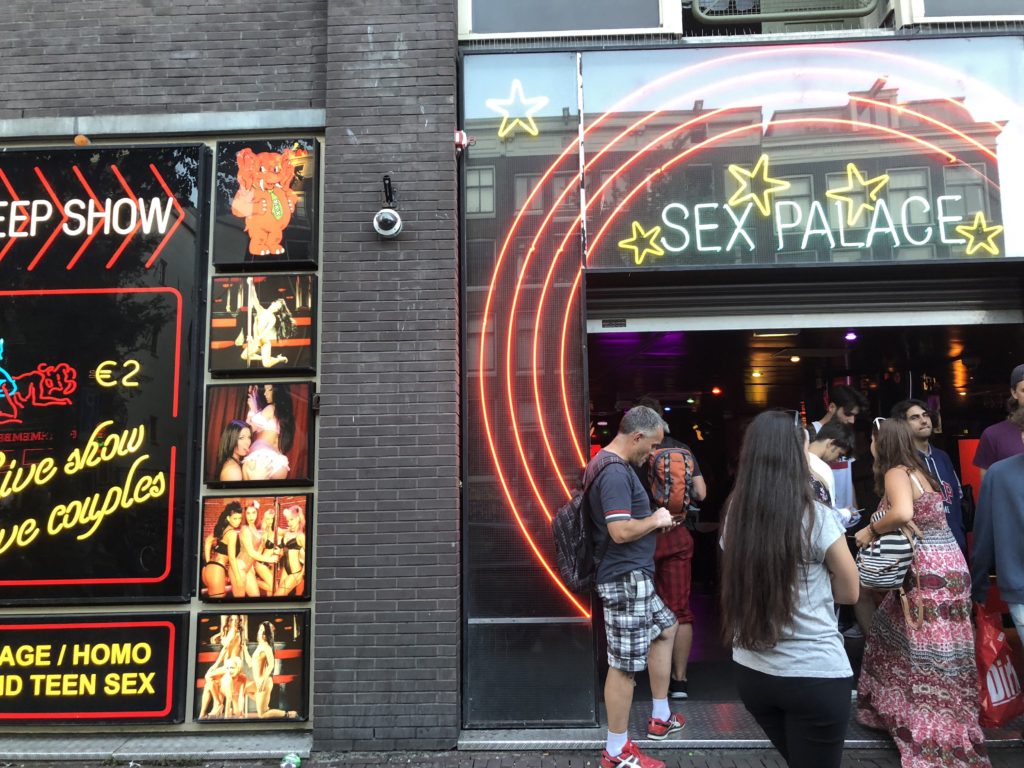
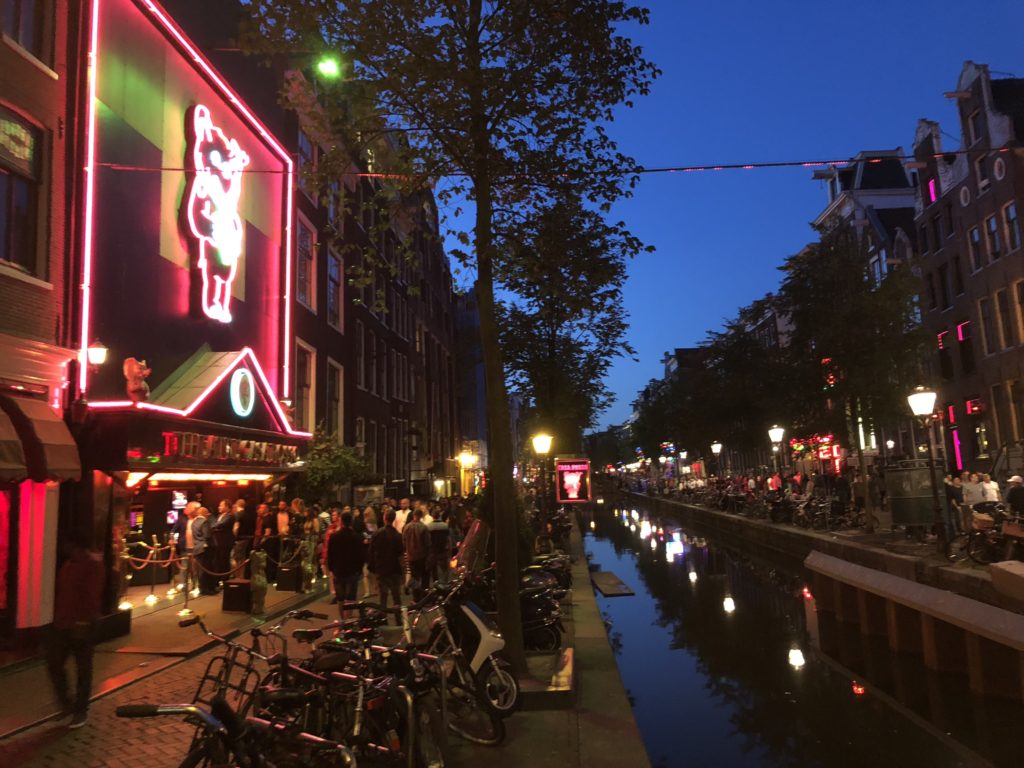
I will not write much about it now, because I plan to write an article about this when I get back to China. But I must say that I’ve learned a lot during the two weeks in Amsterdam. The city itself is the classroom. I was constantly exploring, observing and recording. There is never enough time for me to capture everything I’ve been amazed at! Till next time Amsterdam!
2018.7.15
Day 15 : Arrived in Belgium!
We just took the bus to Belgium today. At night, I watched the World Cup Final with my friends. Croatia lost 2:4 to France, so we weren’t too happy as Croatia supporters.
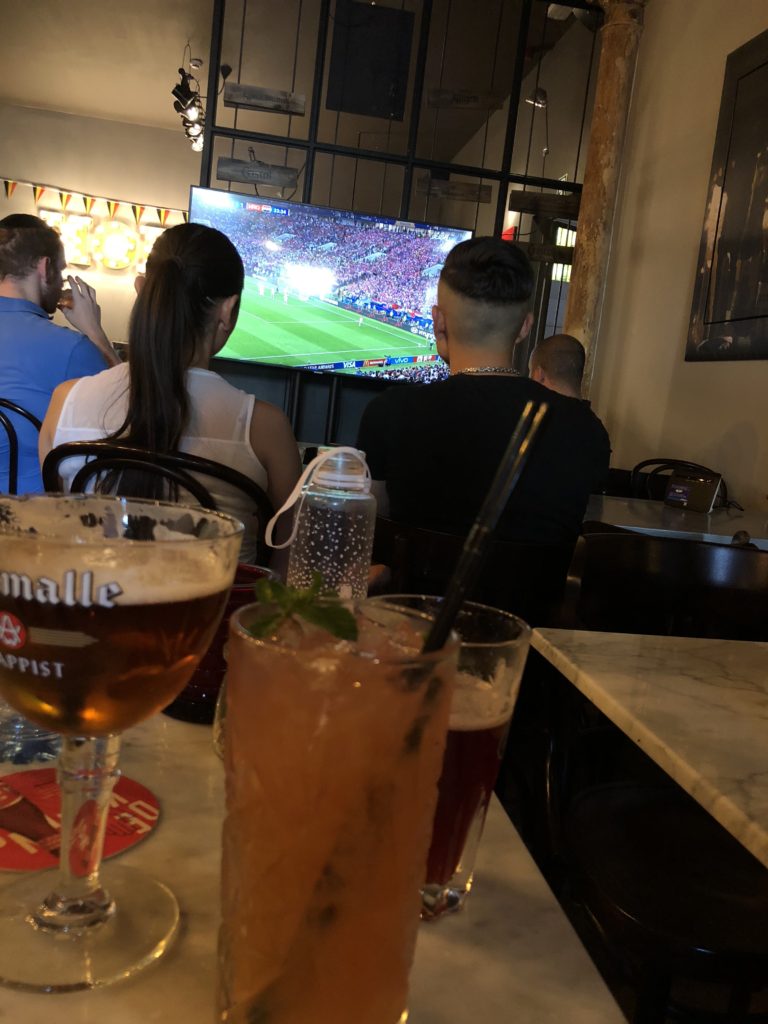
Then we had dinner in a beer bar, called Billie’s Bier Kafetaria (named after the cute bulldog raised by the restaurant’s owner). Belgium beer is indeed the best beer!
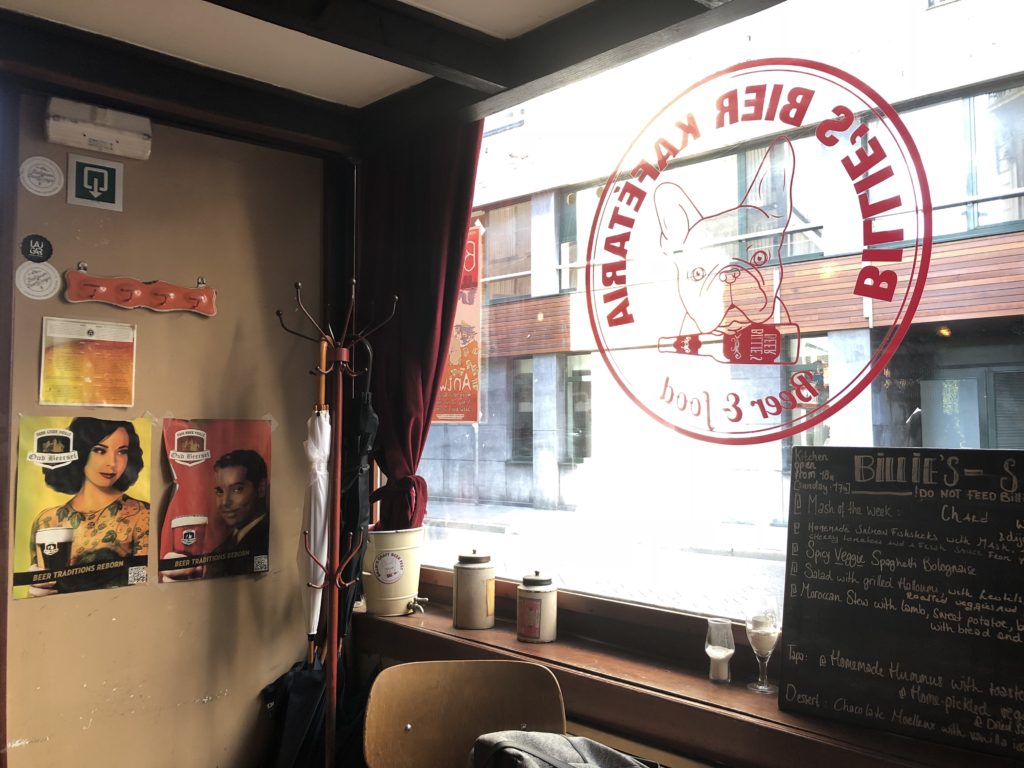
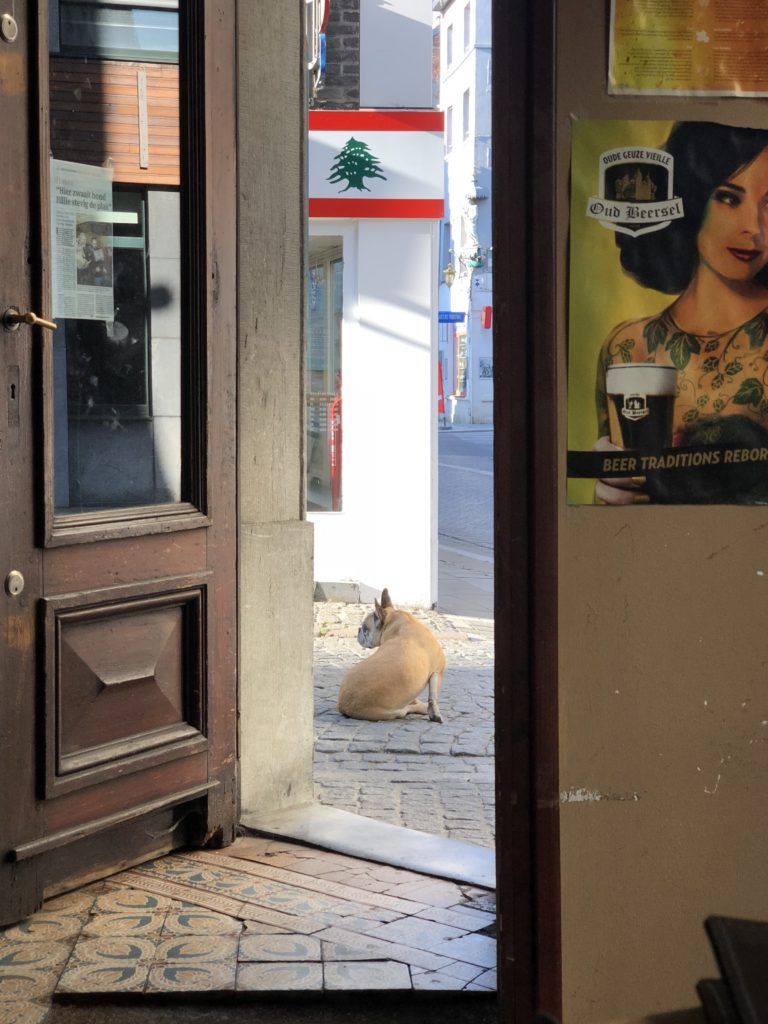
The hostel here is much quieter and has less people. After dinner, I played the football board game with friends and then practiced piano in hostel bar. In the yard, young teenagers were playing pingpong and football, while blasting rap songs.
